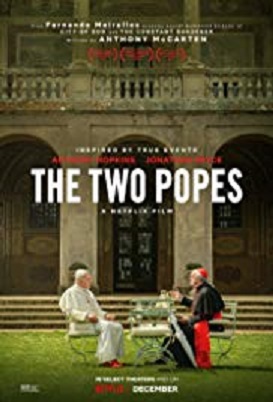WELL WORTH WATCHING, INTERPRETING 'THE TWO POPES'
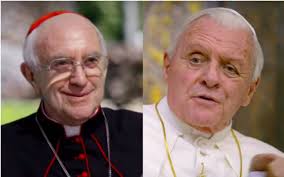
THE TWO POPES
UK/Argentina/Italy/US, 2019, 125 minutes, Colour, Jonathan Pryce, Anthony Hopkins, Juan Minujin. Directed by Fernando Meirelles.
There are many reasons, good reasons, to see The Two Popes. Some of them are worth noting before the consideration of religious themes.
- First of all, there is the articulate and elegant writing by New Zealand-born screenwriter, Anthony McCarten, who was responsible for the screenplays of The Theory of Everything, a portrait of Stephen Hawking, The Darkest Hour, a portrait of wartime Winston Churchill, Bohemian Rhapsody, a portrait of Freddie Mercury and Queen. He has done his research on Pope Benedict and Pope Francis, drawing on many of their statements as well as using his imagination to create conversations between them. The screenplay is both serious and funny, in English, Spanish, touches of German, Latin, and a significant component of God-language.
- Then there are the performances, two fine actors, Anthony Hopkins a credible Benedict XVI, a ‘behind the scenes’ performance Jonathan Pryce a vigorous Francis. The film has a fine Brazilian director, Fernando Meirelles, whose films include City of God, The Constant Gardener, Blindness – and the opening of the 2016 Rio Olympic Games.
- And the look of the film is striking, the stylish photography, the Vatican settings, the 2005 conclave, the Sistine Chapel, the papal apartments, St Peter’s and the Piazza, the Cardinals staying at Santa Marta, a visit to Castel Gandolfo. By contrast, the film brings Buenos Aires alive, first of all in the 21st-century, the outdoors ministry of Cardinal Bergoglio, then black and white flashbacks to his younger years, his vocation decisions, and then a dramatisation of the drastic years of the Generals, especially in the 1970s.
- There are also some surprises with the musical score, not just the expected serious and religious themes, some classical music, but a number of more contemporary songs, creating atmosphere as well as some touches of irony.
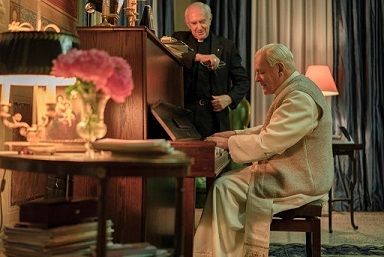
Some articles about the film indicate that it is principally conversation between the two popes, their meetings in 2005, Cardinal Bergoglio’s visit to the Vatican in 2012 to persuade the Pope that he should resign as Archbishop of Buenos Aires. While this is at the core of the film, there is a great deal more.
- Some of the issues that the conversations highlight include the stances of each of them concerning belief and doctrine, the traditional teachings of the church, contemporary moral issues. Part of the drama is that they do not see eye to eye on some of these issues, the difficulties of combining authority and tradition with pastoral demands. But, as indicated earlier, there is quite a deal of God-language, discussions about faith and prayer, the two men devout, a confession sequence, Benedict to Francis, which takes the film beyond ordinary dialogue.
It will be interesting after the film’s release, in cinemas first and then on Netflix, making it more immediately available all around the world, to hear the comments of those who favour John Paul II’s and Pope Benedict’s perceptions of the church compared with those who tend, enthusiastically, to favour Pope Francis and his evangelisation outreach. The differences between the two popes are made quite clear early in the film but, as they converse, with strong initial tensions, as they get to know each other, listen to each other’s stories, prepare the way for Benedict’s resignation and its consequences, there is a great deal more in the meeting of minds and hearts.
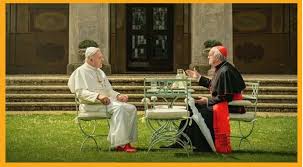
- Because the film is very sympathetic to Pope Francis (not neglecting the criticisms of him when he was Jesuit provincial in Argentina and was seen to side too much with the authorities), the portrait of him is more extensive than that of Pope Benedict. As indicated, we are taken back quite extensively to Cardinal Bergoglio’s life, black-and-white photography of him as a young man, searching for his vocation, a recurring image of him sitting alone in the mountains reflecting, the possibility for marriage, his choices and entry into the seminary (filmed in black and white). Audiences who might not be fully aware of the controversy about Bergoglio and the generals, his turn as provincial wanting to protect the lives of the Jesuits, asking them to close some of their ministries because they were considered too dangerous, some defiance and him on the part of social-minded, confreres, will find this section of the film quite arresting. But, there are sequences enabling Cardinal Bergoglio to admit mistakes publicly, to be sorry for the decisions that he had made, to reconcile with some of his conferences. These experiences enable him, as Archbishop of Buenos Aires to reach out to the poor.
- The Bergoglio who emerges from these sequences is an educated man, a religious leader, a man who admits mistakes, who is transformed into a social-minded pastor, an extrovert who is comfortable in meeting all kinds of people, enjoying their company (especially in supporting his football team, San Lorenzo), familiar with aspects of popular culture. (An amusing episode occurs where Benedict tells Francis that his piano CD was made it Abbey Road leads to a talk about the Beatles!)
- By contrast, there is no visual portrait of Benedict’s life. There are verbal references, and his saying that he was more introverted, bookish, intellectual, and had not any of the pastoral outreach of the Bergoglio. (Audiences may well enjoy a sequence where the two are in a side sacristy of the Sistine Chapel, tourists arriving, Benedict’s decision for the two to walk through the Chapel, the tourists becoming excited – and a number of selfies!).
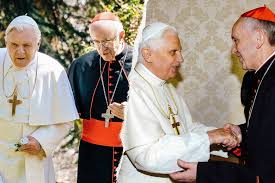
And so, the film and its narrative are multi-layered.
- The narrative goes back to the death of John Paul II and the preparations for the subsequent conclave, sequences of Cardinals discussing with each other, the possibility of Cardinal Bergoglio being elected, Cardinal Martini of Milan advising colleagues not to vote for him, Cardinal Ratzinger seemingly eager enough to become Pope. There is a dramatic tension in the conclave – the details of some of the voting, the black smoke, the white smoke, the emergence of Benedict, and Cardinal Bergoglio going back home, but seemingly steady pontificate.
- Towards the end of the film there will be the 2013 conclave, the discussions, the assembly, the voting, the acceptance – and Francis not wanting special shoes, not wanting the ermine cape (“the carnival is over”), emerging to the cheering crowds and simply saying, “Buena Sera” (good evening).
Audiences interested in the contrast between the approaches of Benedict and Francis will find these sequences illustrating the different points of view, the needs of the church in the 21st-century, the issue of clear guidance and authority compared with a more horizontal metaphor of the church rather than the hierarchical pyramid, pastoral needs and evangelisation.
- Which means then that involved Catholics, with faith and loyalty, will find this two hour immersion into the life of the church of great interest, of encouragement. For nominal Catholics, the film offers an occasion, even an invitation, to more thought and assessment, re-assessment. It will be the same for lapsed Catholics. For ecumenical and interfaith audiences, the drama is both attractive and thought-provoking. And for non-religious audiences, they will appreciate good drama, good writing and performances, character studies – and an opportunity to give further thought to the credibility, life and mission of the Catholic Church.
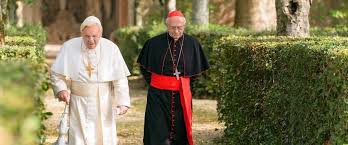
But, audiences will have two, at least, aspects of conversation about the film.
- Questions arise, as they have done during the two pontificates, about tradition and openness of the church. Vatican II was about opening the windows and renewal and updating. John Paul II was committed to doctrinal orthodoxy but also to extensive world travel, showing the human, and frequently genial, face of the church. Benedict, had to move out of his preference for reserve, and continue John Paul II’s two aspects of church life, authority as well as the human face. With Francis, and this is very strongly highlighted in the film, the tradition is important but the pastoral interpretation of tradition is the great challenge, the realities of evangelisation in the contemporary world, pastors and their having “the smell of the sheep”.
- Most most audiences will enjoy the way these emphases are illustrated, from his whistling Abba’s Dancing Queen (which actually is also used in the background as the fully robed Cardinals enter the Sistine Chapel for the conclave!), some Latin American musical background, Pope Francis trying to book a ticket to Lampedusa online and failing (the film actually opening and closing with this episode), buying pizza in a shop near the Vatican (and later persuading a Vatican authority to go out and get some takeaway pizza for himself and Benedict to enjoy), Francis and his TV football watching, his jokes. Benedict does not always get them, then realises that they are jokes – and, amusingly, when he himself makes a joke, not so funny, he tells Francis that this was a German joke and German jokes are not meant to be funny! So, the human face, the humour.
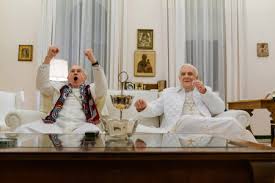
In these senses, The Two Popes might be seen as an exercise in evangelisation to the world in the Francis’ mode.
- At the core of the conversation is Benedict’s resignation. There is a dramatic build-up in so far as Cardinal Bergoglio travels to the Vatican, continually tries to persuade Benedict to accept his resignation. Because of the differences in perspective between the two, Benedict says that the resignation might be interpreted as a criticism of Benedict’s direction of the church. So, there is much discussion to illustrate the different perceptions of each of the men.
- However, with the issues of mismanagement in the Vatican bank, with the pressures of being Pope, Benedict’s advancing age, he turns the tables and shocks Bergoglio with the news that he wants to resign. Interesting that Bergoglio thinks that this is impossible, unthinkable. But, audiences will find fascinating this dramatising of the two points of view, the continuing conversations, Benedict reasoning, Francis’s change of mind – with a wry observation put in Benedict’s mouth that the papal successor usually acts as a corrective to the previous Pope and he will be glad to be alive to see his corrective! There are several mentions that rather than compromise, well-considered change is preferable.
- The bonds between the two men and increasing mutual understanding prepare them for the actual resignation, the amazement throughout the world, the next conclave (and a scene where Benedict watches the white smoke on television in the papal apartment), the emergence of Francis.
The film then takes the advantage of quoting Francis’s words of social concern, his first trip outside the Vatican to Lampedusa to meet refugees who had sailed across the Mediterranean from North Africa, images of small boats and overwhelming waves, the faces of those in need. To that extent, the ending is venture into preaching, social preaching.
Given the significance of the two Popes themselves, the papacy in the Catholic Church at the beginning of the 21st-century, the continued dialogue between tradition and pastoral outreach, the questions of what the Catholic Church should be and will be, The Two Popes is certainly worth watching – and watching again.
SIGNIS STATEMENT (WORLD CATHOLIC ASSOCIATION FOR COMMUNICATION) - PETER MALONE MSC
